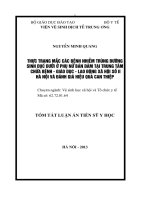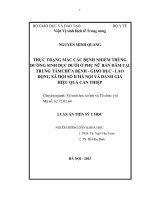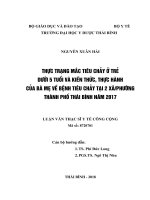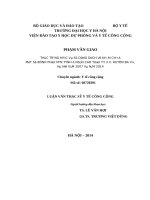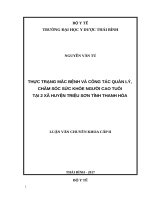thực trạng mắc các bệnh nhiễm trùng đường sinh dục dưới ở phụ nữ bán dâm tại trung tâm chữa bệnh giáo dụclao động đánh giá hiệu quả can thiệp bản tóm tắt tiếng anh
Bạn đang xem bản rút gọn của tài liệu. Xem và tải ngay bản đầy đủ của tài liệu tại đây (260.57 KB, 35 trang )
1
MINISTRY OF EUDCATION AND TRAINING MINISTRY OF HEALTH
NATIONAL INSTITUTE OF HYGIENE AND EPIDEMIOLOGY
Nguyen Minh Quang
PREVALENCE AND INFLUENCING FACTORS OF THE LOWER
REPRODUCTIVE TRACT INFECTIONS AMONG FEMALE SEX WORKERS IN THE CENTRE FOR TREATMENT -
REHABILATION - EDUCATION - SOCIAL LABOUR II HANOI AND EVALUATION OF THE INTERVENTIONS
Speciality: Social Hygiene and Health Administration
Code: 62.72.01.64
THESIS SUMMARY
SUPERVISORS:
2
1. Associate Prof. Ngo Van Toan, MD., PhD.
2. Do Hoa Binh, MD., PhD
Ha Noi - 2013
3
THE THESIS WAS COMPLETED
NATIONAL INSTITUTE OF HYGIENE AND EPIDEMIOLOGY
SUPERVISORS:
1. Associate Prof. PhD. NGO VAN TOAN
2. DO HOA BINH, MD. PhD
Opponent 1:
Opponent 2:
Opponent 3:
The thesis will be defended at the Assessment Commetee at Institute Level
The defend at National Institute of Hygiene and Epidemiology
Time: date month 2013
4
The thesis stored at:
- National Library
- National Institute of Hygiene and Epidemiology Library
5
PUBLICATIONS
1.
Nguyen Minh Quang, Bui Van Nhon, Ngo Van Toan (2012),
“Prevalence of lower genital tract infections among female sex workers
in Hanoi Social Education Labor Centre in 2009-2011”, Journal of
Medical Research, Volume 80, N
0
3.
2.
Nguyen Minh Quang, Bui Van Nhon, Ngo Van Toan, Do Hoa Binh,
Nguyen Thi Thuy Duong (2012), “Risk behaviors of the lower sexual
tract infections among female sex workers in Hanoi Social Education
Labor Centre in 2010”, Journal of Preventive Medicine, Volume XXII,
N
0
6 (133).
3.
Nguyen Minh Quang, Bui Van Nhon, Ngo Van Toan, Do Hoa Binh,
Nguyen Thi Thuy Duong (2012), “Effectiveness of intervention
measures to prevent the lower genital tract infections in female sex
workers at Centre 02 in Hanoi city, 2010-2012”, Journal of Preventive
Medicine, Volume XXII, N
0
6 (133).
6
INTRODUCTION
1. Rationale of the thesis
WHO defined that infections of lower reproductive tract (LRTI) are genitials infections including STDs and others.
LRTIs are common, dificult to determine exactly the the incident rates of the differente teritories, especial in sex
workers (SW). The rate of LRTI is general high from 41-47% in the world. In Vietnam, a study in 2005 reported
81.3% abnormal of reproductive tract, including 66.6% LRTI, closely related to HIV, sinificant hight in FSW.
Risks of LRTI in FSW are lack of knowledge and practising to prevent STD, including unsafty exual, less of
condom using, many kinds of sex partners, unsatisfy contraception The stydy on efectiveness of LRTI preventive
measures was carry out and it is pointed that the most effected solution is using condom for all sexual intercourses.
In Vietnam, there are some stydies in effectiveness of prevention HIV, however the systematic studies on LRTI are
very rare. This sudy aims to indicate the risk factors and efectiveness of interventions, in order to improve the
knowledge and practising to prevent LRTI in FSWs , who are concentrated for treatment, rehabilation, education
and social labor in the Center II, Ba Vi, Hanoi. The subjects of study are:
7
1. Describe the incidences and risk behaviors of LRTIs in female sex workers, who are concentrated in the
Center for Treatment, Rehabilitation, Education and Social Labor II of Hanoi in 2011.
2. Evaluate the effectiveness of interventions to prevent lower genital tract infection for female sex workers and
improve the knowledge of sexually transmitted infections for medical staffs in the Center for Treatment,
Rehabilitation, Education and Social Labor II of Hanoi, period 2011-2012.
2. New contributions of the thesis
This is the first systemetic study on LRTI with evaluations on incidences and efectiveness of interventions, in order
to improve the knowledge and pratising for FSW, who were being in the Center II.
The thesis has proved the evidence on effectiveness of interventions by training, LRTI screening for FSW and
performance on training to improve knowledge on managing LRTI for medical staffs of the center. The thesis has
identified the high incidence of LRTI in FSW and the role of condom using to prevent LRTI for all sexual
intercoureses with all clients, it is also mentioned the effect of media education, advantage of initiative health care
to reduce LRTI diseases in FSW.
The study results are used ful for the policy and planning programs in order to expand this intervention modul for
the other centers over the nation.
3. Scientific and practical meanings of the thesis
Scientific meaning: The study uses community intervention design, meets to subjects of research , data collection
and analysis are exactly , has proved remarkable effectiveness on interventions by media education, initiative
health care for FSW, has improved knowledge of managing LRTI for medical staffs of the center.
Practical meaning: The results of the thesis has performed the effectiveness of the intervention model to help
planners and policy makers as well as presventing LRT for FSW and improve knowledge and pratising STD
managing for health workers, base on that to expand this intervention model for other centers over the nation.
4. The layout of the thesis
The thesis is presented in 124 pages, excluding appendixes and is divided into:
Introduction: 2 pages
8
Chapter 1: Overview: 35 pages
Chapter 2: Subjects and Methods of study: 198 pages
Chapter 3: Research Results: 36 pages
Chapter 4: Discussion: 27 pages
Conclusions: 2 pages
Recommendations: 1 page.
There are 41 tables, 11 charts.
The appendix includes 151 references (57 Vietnamese, 94 English), Questionnaires sheet, List of FSW , List of
staffs involved in the training.
Chapter 1
OVERVIEW
1.1. Basic conceptions of LRTI:
By WHO, infections of lower reproductive tract (LRTI) are infection disease caused by or not by sexual
transmition disease (STD) including vulgaris, vaginalis and cervicitis.
1.2. Prevalance of LRTI and risk behaviors
1.2.1. Prevalence of LRTI
Gonorrhea: caused by Streptococcus Gonorrhea. Studies in 5 provinces showed the incidence is 3.2 %. Nguyen
Trong Thuc reported on his Sentinel surveillence
Research in 4 southest province, the Gonorrhea incidence in FSW was 4.64 %. This ratio is higher in the North and
Middle of Vietname, the research in 5 North border provinces described with 11.9% Gonorrhea in FSW. The
Gonorrhea ratio in the neiboring contries are 5.7 % in Cambodia and 9.5 % in China.
Syphilis: caused by Treponema pallidum . Research in 5 border provinces of Vietnam showed the incidence rate is
10.7 % in general, highest is Quang ninh (24.8 %) and Lai Chau (20.2 %) and 03 remains provinces of Dong Thap,
An Giang, Kien Giang have rates ranging 5.7 - 9.4 %.
9
Chlamydiasis: is one of STD cause by Chlamydia,a parasite stained Gram (-) color. A research in Provinces of
Mekong Delata indicated 3.5 % FSW has positive with Chlamydia. Foreign researches on FSW reported incidence
rate ranging 12% -2 7.0 % in Asia and Europe countries.
Trichomatis: caused by Trichomonas, a parasite of anaerobic protozoa, round shape with diameter 10-20 µm. The
incidence rate ranging 2-2.5 % in general and 50-70 % in FSW over the world. In Vietnam LRT Trichomatis
incidence rate 8.13 % in FSW and 0.84 % in pregnants are reported.
Fungal LRTI: cause by Candidas Albicans and some time by other strains. Candidas Albicans is also causing
fungal diseases in many organs such as the skin and mucosal infections, Septicaemia, endocarditis, meningitis. The
incidence in Haiphong province is 10.7%, highest among 5 researched provinces. Research in 2005 showed fungal
LRTI incidence rate is 11.9 % of FSW in 4 South provinces.
Reproductive papiloma: caused by Human Papiloma Virus (HPV). Typical sumptoms are red-brown soft warts,
glomerate in vulva, vagina, cervix. The lessions evoke itching, discomfort due to increasing secretion, easy to bleed
by touch. Dianosistic based on physical symptoms, cervix luminate, HPV determine by PCR technique. HPV
papiloma has high ratio in FSW, accounting for 9.2 %.
Reproductive Herpes: caused by Herpes Simplex Virus type I, II. It 's leading to obstetric accidences such as
miscarriage, premature give birth, premature placental detachment. Research in Hai Phong province showed the
incidence rate in FSW is 3.9 % in FSW, 32.8 times higher than the lower risk groups.
Complex microbial LRTI - vulgaris, vaginalis: the pathogens are nonspecific, diversity. Clinic symptoms are
homogeneous liquid discharge with white or gray color, stinking smell. Some local and overseas studies reported
the incidence rate of complex microbial vulgaris, vaginalis without symtoms are quite hight (50-70 %).
1.2.2. Factors and risk behaviors afects to LRTI in FSW
Age is an important factor of LRTI in teenagers. Studied in Central Institute of Dermatology of Vietnam 2003-2005
and other researches indicated the incidence rate tend to be higher in women over 20 years old than the women
under 19 years old.
10
The incidence rate of LRTI is usually higher in group has low education and and unstable careers. This is also a
difficult matter on education to improve practising of LRTI prevention. In fact, the low education group has shown
the poor knowledge of LRTI and unsafty sexual activities, unsafety injection that entrain to high incidence of HIV
and LRTI.
Career is important factor related to LRTI and HIV infection, the incidence rate are 14.7 %; 13.1%; 13.1 % and 8.4
%, correlatively in the groups of workers, freelances, market sellers and students.
Having unsafty sex is risk to be infected HIV and LRTI, in countries with high prevalences of HIV & LRTI, were
recognised the main cause of very low rate of condom using (condoms). In a study in the southern provinces
showed that 65% of female sex workers do not use condoms during sex courses, HIV prevalence in this group
was 5.2% and the proportion accounted for LRTI is high (above 80%). Average number of customers / month
is one of the high-risk factor to be infected HIV and STD in FSWs. Research by Centre for Disease Prevention
and Control showed up to 80% of cases LRTI does not use condoms regularly, compared with 2% of LRTI
cases in FSWs often use of condoms in sexcourses with clients and partners. The initiative to get the tests of
LRTI is meaningful in preventing infection LRTI for their clients, husband / partner and also help the women
be able to access the treatment in cases of LRTIs.
1.3. The LRTI prevention models
1.3.1. Communication programs for behavior change
The main purpose of communication programs for behavior change is to increase awareness, knowledge,
understanding of transmission LRTI and prevention measures for all the people, forthe high risk groups, eapecial
FSWs. Communication programs for behavior change aims to access the high-risk groups, differentiate to the other
media is for community. This program also provide information of to prevent LRTIs and provide services, which
support to change behaviors and maintain safety sex by using condoms, resist drug abuse and personal hygiene
guide.
1.3.2. The program of 100% condom using
The program encourages FSWs to use condom for 100% sexual intercourses (says as program 100% condom) is
not simply to provide condom, but it includes many activities to improve the awareness, knowlege about
11
distribution of condoms, peer education and screening of STD and reproductive tract infections. The aims of
program is to prevent and reduce HIV and LRTI with effectiveness and low cost.
1.3.3. Program of Management LRTI
The person, sho is sufered from LRTI diseases likely to be HIV infected more than 2-9 time compare with the
ordinary subject. Therefore, early detection and treatment of STD are not only make sense to restrict the spread of
HIV through sexual, also are meaningful in management, monitoring LRTI among indicated population.
1.3.4. Peer education program
Peer education program is reachable enough to understand that "the sharing of knowledge, skills and life
experiences between those who have the same characters of social and ecomomy such as age, gender, occupation,
religion, hobbies, in order to change their behaviors". Peer education program is also called "program of
communication accessibilities". In many countries, people have implemented the programs to reduce harm in
community such as peer education.
Chapter 2
SUBJECTS AND METHODS
2.1. Object, location and study duration
2.1.1. Subjects of study
- The women are training in the CenterII (for Treatment,Rehabilitation, Education, Social Labor), located in Yen
Bai commune, Ba Vi District, Ha Noi City, from 2011 to 2012. The time of concentrated training should be t least
12 months to warranty the time of intervention by research and the participants have to voluntary invole to the
study.
- 15 medical staffs and managing persons, who are working in the Center II for Rehabilitation, Education, Social
Labor, Hanoi.
2.1.2. Study site
The study was conducted at the Center II for Rehabilitation, Education, Social Labor, belongs to Department of
Labour, Indisable and Social Affairs of Hanoi, located in Yen Bai commune, Ba Vi district.
12
2.1.3.Duration of research and data collection
From 1/2011 - 12/2012, at Ba Vi district, Hanoi.
2.2. Research Methodology
2.2.1. Study Design
An intervention experimental design, without comparative.
2.2.2. Research sample and sampling
2.2.2.1. Female Sex Workers:
Sample sizes:
2
21
2
22111)2/1(
21
)(
])1()1([)1(2[
pp
ppppZppZ
nn
−
−+−+−
==
−−
βα
Includings:
n
1
: sample size before intervention
n
2
: sample size after intervention
p
1
: prevalence of FSW using condoms for all sexual intercourses, before intervention (estimated 52 %)
p
2
: prevalence of FSW using condoms for all sexual intercourses, after intervention (estimated 65 %)
p: (p1 + p2) / 2, Z1-α / 2: reability coefficient, determined at 95 % (=1.96)
z
1-
β
: force sample (= 80%)
Total: 407 FSWs were studied.
Sampling: The FSWs were selected by the single random sampling, based on a list of all FSWs, who are training
in Center II, Ba Vi, Hanoi.
2.2.2.2. Medical staffs
13
All medical staffs included all 15 doctors, nurses who are working in Center II, Ba vi, Hanoi to be selected in the
study.
2.2.3. Process and means of data collection
2.2.3.1. Process of data collection
2.2.3.1.1. Interview
Interviewed FSWs following questionnaire sheet to collect information of individuals, families, and knowledge of risk
behaviors of LRTI of FSWs.
Interviewed medical staffs to collect personal information and LRTI knowledge of the medical staff of the Centre.
2.2.3.1.2. Clinical examination
Clinical exam to identify the symptoms of LRTsI. Take exam to detect the exsisting STDs: genital ulcer, urethral
and vaginal discharge, stinking odor of discharge, urticaria, abnomal pain, papilome.
2.2.3.1.3. Tests
The dicharge of lower genital tract and blood are testing find the pathogens of LRTIs. The LRTIs to be studied are
including: Gonorrhea, Syphilis, Trichomoniasis, Chlamydia, fungi and complex bacterial.
2.2.3.2. Means of data collection
The interview questions sheet contains: the administrative part, personal characteristics, risk behaviors of FSWs
and knowledge, skills of medical staffs. Clinical examination leaflet, blood tests, discharge test.
2.2.4. Technical tests
The testing techniques to find pathogens were performed under the guidlines of WHO and the Central Hospital of
Dermatology.
2.2.5. Content and intervention process
Examination, treatment for FSWs and monitoring of clinical and laborator expressions. Communication and
education activities focused on prevention of sexually transmitted diseases, which is currently conducted at the
14
Center, included: organized the direct education, communication via leaflets, media by film/television, consult
directly. Training for medical staffs to perform screening, exam and treatment of LRTI and STDs for FSWs.
2.2.6. Analysis
The data has been analysis and presented by frequency and % ratio. Test χ
2
and p value expressed the difference
between independent variable and dependent variable. Estimation Test (OR) and 95% CI was used to identify the
relation between LRTI ratio and individual characteristics, risk behaviours of FSWs. Multivariable regress analysis to be
used for error exclussion of indipendent and depend variables relationship. Effectiveness indicator to be count for
determining of intervention effects.
2.2.8. Ethics in Research
The objects have informed the aims of study and to be volunteered. All information is secured by encription and
used for this dtudy only. The research author have not to utilitize any inlegal supplemtation or service during study
process.
Chapter 3
RESULTS OF STUDY
3.1. Some personal characteristics of FSWs
Among 407 FSWs, the youngest is 15 years old and the oldest is 40 years old. Mean age was 26.8 ± 6.29 years,
minimum 15 and maximum is 40 years old. Most FSWs were currently concentrated on training in the Center are
Kinh ethnic group, accounting for 59%, the proportion of FSWs used to live in rural areas is very high, accounting
for 93.4%. Before to be FSWs, most of them were worked in agriculture (63.6%), continuous by groups of jobless
and freelance (14.3% and 14%). The education level of FSWs was low, averaging 6 ± 3.8 years. FSW illiteracy rate
was 14%, primary school was 28%, secondary school was 45.5% and high school was 12.5% only.
15
Medical staffs group ≤ 30 years has highest for proportion (60.0%). Mean age was 29.8 ± 6.6 years old. There are 60
% of medical staffs are women, highest proportion is nurse (46.7 %). Working experience of medical staffs devided 02
groups: under 5 years, accountd for 46.6 % including 3 staffs just got 01 working year; 5-10 years and 11-20 years,
accounted for 26.7 %. One of them has trained of LRTI treatment (6.6 %).
3.2. Incidence prevalence, influent factors and risk behaviors of female sex workers
3.2.1. The clinical symptoms of LRTIs
In FSWs, the rate of at least one symptom associated with LRTI when entering the Center was 34.2%. The most
common symptoms reported in FSWs is abnormal vaginal discharge (24.8%), followed by itching in the genital
area (14.7%), abdominal pain (13.3%). Other symptoms were genital sores (10.6%), sharp pain urine (9.3%) and
lowest was genital ulcers (8.4%).
3.2.2. Incidence prevalence in FSWs
Incidence prevalence of LRTI in FSWs when entering the center is high in clinical, accounted for 67.1%.
16
Chart 3.9. The lession morphology of lower genital/reproductive tract infections
The most common infection was vulvo-vaginalis (49.9%), single vaginalis (21.9%), single cervicitis (8.8%).
Especially with 7.9% of FSWs had cervical cervicitis.
17
Chart 3:10. Ratio of pathogens of lower genital tract infection (n = 273)
When entering the center, rate of complex microbial infection in FSWs was highet, accounted 44.7%, following by
fungal infection 10.1%, Trichomonas, 4.4%, syphilis 2.5% and gonorrhea is lowest, accounted for 0.5%.
3.2.3. Analysis the affected factors and pathogens of lower genital tract infections in FSWs
Table 3.17. The relation between pratising/whored time and LRTIs
Whored time
Infection
(n=273)
Non-infection
(n=134)
OR 95%CI
Quantity % Quantity %
≥ 1 months
< 1 month
174
99
72.8
58.9
65
69
27.2
41.1
1
0.6 0.38-0.81
18
FSW group < 18 years old had a higher rate than the FSW group > 18 years old (70% compared with 66.2%).
There was 58.7% FSWs had whored time ≥ 1 month . The rate of LRTI in FSW group of whored time ≥ 1 months
is higher than FSW group of whored time < 1 month (72.8% compared with 58.9%). This difference was statistic
meaning.
Table 3.18. The relationship between the average sex client and LRTI
Number of the
clients
Infection
(n=273)
Non-infection
(n=134)
OR 95%CI
Quantity % Quantity %
Clients / month
1-9 clients
10-19 clients
≥ 20 clients
96
38
139
66.2
70.4
66.8
49
16
69
33.8
29.6
33.2
1
1.2
1.0
0.58-2.53
0.64-1.65
New clients / month
0 client
1-2 clients
3-5 clients
≥ 6 clients
18
131
19
25
52.9
71.3
64.5
67.6
16
56
50
12
47.1
38.7
35.5
32.4
1
2.1
1.5
1.9
0.93-4.65
0.85-3.24
0.64-5.44
In general, LRTI rate of FSW group had 10-19 clients/month is higher than the other FSW groups (70.4%
compared with 66.2% and 66.8%) . However, this difference is not statistic meaning. Rate of LRTI of FSW group
had 1-2 new clients / day was higher than the other groups (71.3% compared with 67.6%, 64.5% and 52.9%). This
difference is also not statistic meaning. LRTI rate of FSW group had ≥ 6 regular client was higher than the other
FSW groups (71.1% compared with 64.2%, and 58.7% ). This difference was statistic meaningl.
19
Table 3.19. The relation between behavior of condom use and LRTI
Behavior of condom
use
Infection
(n=273)
Non-infection
(n=134)
OR 95%CI
Quantity % Quantity %
With new clients
No
All times
240
33
69.2
55.0
107
27
30.8
45.0
1
0.6 0.32-0.95
With regular clients
All time
No
140
133
60.9
75.1
90
44
39.1
24.9
1
1.9 1.21-3.34
With husband and lover
Yes
No
108
165
65.5
68.2
57
77
34.5
31.8
1
1.1 0.58-1.34
The LRTI rate of FSW with new clients groups had used condoms for all sexualcourses was lower than the FSW of
correlative group had'nt used condom for all sexualcourses (55 % compared with 69.2%). The LRTI rate of FSW
with regular clients groups had used condoms for all sexualcourses was lower than the FSW in correlative group
had'nt used condom for all sexualcourses (60 , 9% compared with 75.1%).
Table 3.20. Initiative health screening behavior and LRTIs
20
Initiative
medical care
behavior
Infection
(n=273)
Non-infection
(n=134)
OR 95%CI
Quantity % Quantity %
Initiative examine
No
Yes
181
92
69.6
62.2
79
55
30.4
37.4
1
0.7 0.51-1.20
Initiative test
No
Yes
179
94
69.9
62.3
77
57
30.1
37.7
1
0.7 0.92-2.15
Only 36.5% FSWs got initiative medical exam and 37.1% FSWs got initiative test. The LRTI rate of FSWs without
initative exam and test was higher than correlativeness. However, this difference is not statistic meaning.
Table 3.21. Understanding of infedelity sex, condom use and LRTIs
Understanding
Infection
(n=273)
Non infection
(n=134)
OR 95%CI
Quantity % Quantity %
Infidelity sex
Right
Wrong
203
22
66.6
71.0
102
9
33.4
39.0
1
1.2 0.81-1.82
21
Understanding
Infection
(n=273)
Non infection
(n=134)
OR 95%CI
Condom use
Right
Wrong
226
15
67.7
68.2
108
7
32.3
31.8
1
1.1 0.36-3.84
Right understanding FSW group had LRTI rate lower than the wrong group (66% compared with 71%). However,
this difference was not statistic meaning. Percentage of LRTI in FSW who wellknowed of condom use for all
sexcourses was lower than the misunderstading group (67.7% compared with 68.2%). However, this difference is
not statistically meaningful.
Table 3.22. The relation between self-assessment of risks and LRTIs
Self-assessment
Infection
(n=273)
Non-infection
(n=134)
OR 95%CI
Quantity % Quantity %
High risk
Low rist
No risk
Did'nt know
29
39
98
107
75.2
57.4
72.6
66.2
11
29
37
57
27.5
42.6
27.4
34.8
1
0.5
1.0
0.7
0.20-1.28
0.42-2.36
0.71-1.62
22
Only 9.8% FSWs had self assessment for LRTI risks (for both FSWs with or without the disease), 16.7% self-
assessment for low risk, 33.2% self-assessment in no risk and 40.3% did not know whether they were at risk of
LRTI or not. No relation was statistic significant between self-assessment and risk of LRTIs.
Table 3:25. Relation between personal characteristics, risk behaviors and LTRIs by multivariative regression
model
Personal characteristics and behavior risks OR 95% CI
Age 1.2 0.78-1.79
Ethnic group 0.8 0.53-1.34
Teritory 0.6 0.60-1.51
Education 1.1 0.66-1.36
Age of 1st sexcourse 1.2 0.72-2.08
Number of clients / month 1.1 0.81-1.36
New clients / day 1.1 0.78-1.49
Regular clients / day 1.0 0.78-1.33
New clients used condom for all sexcouses 2.5 1.07-4.09
Regular clients used condom for all sexcouses 2.3 1.12-4.10
Initiative medical exam 0.9 0.43-2.05
Iniative medical test 1.5 0.69-3.31
Self-assessment LRTI risks 1.0 0.95-1.09
Study with multivariative regression model of the relation between personal characteristics and risk behaviors with
LRTI showed that no condom use for all sexcourses lead to incease risks of LRTIs. The other factors was not
significantly influenceto the incidence statistics of LRTIs.
3.3. The effectiveness of the intervention measures to prevent LRTIs
3.3.1. Knowledge:
23
FSW understanding rate of the clinical symptoms of LRTI was much higher compared with the it's figure when
FSW entered the center (51.4% to 98%). This difference was significantly meaningful for statistic with p <0.001
and efficiency indicators (EI) was 86.1%.
3.3.2. Attitude:
Table 3.27. Effectiveness of improvement to prevent LRTI
Preventive attitude
Before intervetion
(n=407)
After prevention
(n=407)
p
Effectievness
figure (%)
Quantity % Quantity %
Infidelity sex
Right
Wrong
Does'nt know
305
31
71
74.9
7.6
17.4
403
0
4
99.3
0
0.7
<0.001 32.6
All sex uses condom
Right
Wrong
Does'nt know
334
22
51
82.1
5.4
12.5
403
0
4
99.3
0
0.7
<0.01 30.0
FSW attitude to prevent LRTI also highly increased and had significant statistic with high effectivness figure.
Increased level of attitude on the prevention / control LRTI was not as fast as the growth of knowledge.
Table 3.28. Effective of improvement attitude on self-evaluation LRTI risk
24
Self-
assessement of
LRTI risk
Before
intervention
(n=407)
After intervention
(n=407)
p
Effectiveness
figure (%)
Quantity % Quantity %
High risk
Low rist
No risk
Does'nt know
40
68
135
164
9.8
16.7
33.2
40.3
130
31
74
172
31.9
7.5
18.2
42.4
<0.01 225.5
After the intervention, the rate of self-assessment of LRTI risk by FSW was increased from 9.8% to 31.9%. This
difference had significant statistic with p <0.01 and EF is 69.3%.
3.3.3. Reduce symptoms and LRTIs
Table 3.29. Effective in reducing the clinical symptoms LRTI
Clinical
symptoms
Before intervention
(n=407)
After intervention
(n=407)
p
Eff. Fig.
(%)
Quantity % Quantity %
Lower abnonal pain
Yes
No
54
353
13.3
86.7
15
392
3.7
96.3
<0.01 72.2
Discharge / pus
Yes
No
101
306
24.8
75.2
12
395
2.9
97.1
<0.001 88.7
Urinary pain
Yes
No
38
369
9.3
90.7
6
401
1.5
98.5
<0.001 83.9
25
Clinical
symptoms
Before intervention
(n=407)
After intervention
(n=407)
p
Eff. Fig.
(%)
Genital sore pain
Yes
No
43
364
10.6
89.4
17
390
4.4
95.6
<0.01 58.5
Genital lession
Yes
No
34
373
8.4
91.6
3
404
0.7
99.3
<0.01 88.1
Genital pruritus
Yes
No
60
347
14.7
85.3
25
372
6.3
93.7
<0.01 57.1
Some typical symptoms of LRTI as discharge / pus, urinary pain, genital pain pain, genital ulcer / sarchome,
genital pruritus were much reduced. These differences were significanct statistic with p ranging from less than 0.01
to 0.001 and EF ranged from 58.5% to 88.7%.
Table 3.30. The effectiveness of reduced LRTI clinical symptoms
Reduce LRTI
Before intervention
(n=407)
After intervention
(n=407)
p
Eff. Fig.
(%)
Quantity % Quantity %
Vulgaris
Yes
No
36
371
8.8
91.2
17
390
3.9
96.1
<0.01 55.7
Vaginalis
Yes
No
89
318
21.9
78.1
5
402
1.2
98.8
<0.001 94.5
Vulvo-vaginalis
Yes
No
203
204
49.9
50.1
87
320
21.2
78.8
<0.001 57.5
Cervitis
Yes
No
49
358
12.0
88.0
18
389
8.3
91.7
<0.01 30.8
